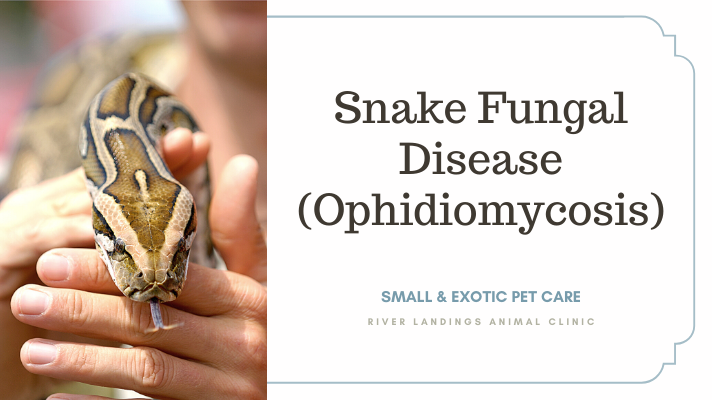Cause of Snake Fungal Disease / Ophidiomycosis
Ophidiomycosis, formerly referred to as Snake Fungal Disease (SFD), is caused by the fungus Ophidiomyces ophiodiicola. This fungus is thought to be an emergent pathogen in North America and poses a significant threat to snake health and population sustainability. To date, O. ophiodiicola has been documented in over 15 types of wild and captive snakes.
Significance of Snake Fungal Disease / Ophidiomycosis
Ophidiomycosis is an emerging disease that affects wild and captive snakes across North America. The incidence of Ophidiomycosis has steadily increased over the last few years, specifically documented in California, Oklahoma, Puerto Rico, and Idaho.
Species Affected by Snake Fungal Disease / Ophidiomycosis
Ophidiomycosis can infect wild or captive snakes and is the predominant cause of skin infections in wild snakes. It has been documented in over 15 types of wild and captive snakes. Species confirmed with diagnosis of Ophidiomycosis include— the eastern indigo snake, the northern water snake, the eastern racer, the rat snake, the timber rattlesnake, the massasauga, the pygmy rattlesnake, garter snakes, cottonmouth snakes, the milk snake, queensnake, and eastern fox snake. The fungus causing Ophidiomycosis is not known to affect humans.
Distribution of Snake Fungal Disease / Ophidiomycosis
As of November 2019, the fungus O. ophiodiicola has been found in at least 38 states, including recent findings in California, Idaho, Oklahoma. It is also present in one U.S. territory (Puerto Rico) and one Canadian Providence (Ontario). In some species (i.e., Eastern Massasauga) the mortality rate may be over 90% in the Eastern US.
Transmission of Snake Fungal Disease / Ophidiomycosis
At this time, it is not well understood how the fungus causing Ophidiomycosis is spread. It is likely that the pathogen is shed into the environment by infected snakes and spread from the environment to other snakes (i.e., snakes that share dens). O. ophiodiicola may be spread via vertical transmission (i.e., from dam to offspring). There is no evidence of horizontal transmission (i.e., snake-to-snake transmission) of O. ophiodiicola. Host and environmental factors that lead to disease remain largely unknown. For example, it is thought that Timber rattlesnake populations are at higher risk of Ophidiomycosis in years with higher rainfall.
Clinical Signs of Snake Fungal Disease / Ophidiomycosis
Clinical signs of SFD and the severity of the disease may vary by species. The most common clinical signs include accelerated ecdysis cycles, flaking and crusting of the scales/epidermis, displaced or discolored scales, granulomas, nodules, swelling or disfiguration of infected tissues. The disease may progress internally (via the eyes, throat, and/or lungs) and cause eye infections or pneumonia.
Diagnosis of Snake Fungal Disease / Ophidiomycosis
Ophidiomycosis is diagnosed by identification of the classic clinical signs in combination with either molecular detection (PCR or qPCR) of the fungus, histopathology, and/or a positive fungal culture.
It must be noted that there may be difficulty in sampling for and detecting (by PCR/qPCR) O. ophiodiicola by skin/epidermal swabs (i.e., low DNA quantity on the skin or the fungi are deep within the epidermis). Therefore, hesitation should be taken in assigning causation to O. ophiodiicola to animals with skin lesions that are qPCR negative in the presence of skin lesions. There are numerous causes of skin lesions in wild snakes (i.e., trauma, another pathogen causing skin lesions, etc). Conversely, the absence of clinical signs of ophidiomycosis is more reliable to eliminate a diagnosis of apparent ophidiomycosis.
Treatment of Snake Fungal Disease / Ophidiomycosis
Treatment with an antifungal, Terbinafine, either by a slow-release, long-lasting implant or nebulization has been found to reach therapeutic levels in cottonmouth snakes; methods and doses for treatment are thus based on these findings. Other treatment options include thermal and nutritional supportive therapy.
Management of Snake Fungal Disease / Ophidiomycosis
Ophidiomycosis appears to be negatively impacting several species and populations of snakes across North America. However, its long-term impact remains unknown. It is also very difficult to assess changing snake populations because of the solitary nature of many snakes and, importantly, the absence of long-term monitoring data for most species of snake. Any sightings of snakes with suspected SFD infection should be reported to the Northeast Wildlife Disease Cooperative and/or DTT Herp Disease Alert System for further investigation. Wildlife specialists, veterinarians, and any other individuals who routinely come in contact with wild snakes should keep gear, snake holding containers, and clothes clean and disinfected to prevent spreading the fungus to other snakes.
Hear From Us Again
Don't forget to subscribe to our email newsletter for more recipes, articles, and clinic updates delivered straight to your e-mail inbox.
Related Categories:


